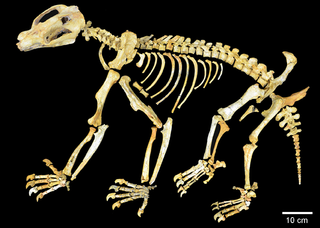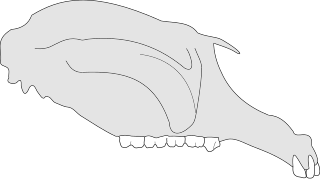
Marsupials are any members of the mammalian infraclass Marsupialia. All extant marsupials are endemic to Australasia, Wallacea and the Americas. A distinctive characteristic common to most of these species is that the young are carried in a pouch. Living marsupials include kangaroos, koalas, opossums, Tasmanian devils, wombats, wallabies, and bandicoots among others, while many extinct species, such as the thylacine, Thylacoleo, and Diprotodon, are also known.

Obdurodon is a genus of extinct platypus-like Australian monotreme which lived from the Late Oligocene to the Late Miocene. Three species have been described in the genus, the type species Obdurodon insignis, plus Obdurodon dicksoni and Obdurodon tharalkooschild. The species appeared much like their modern day relative the platypus, except adults retained their molar teeth, and unlike the platypus, which forages on the lakebed, they may have foraged in the water column or surface.

Marsupial moles, the Notoryctidae family, are two species of highly specialized marsupial mammals that are found in the Australian interior. They are small fossorial marsupials that anatomically converge on fossorial placental mammals, such as extant golden moles (Chrysochloridae) and extinct epoicotheres (Pholidota). The species are:

The order Peramelemorphia includes the bandicoots and bilbies. All members of the order are endemic to Australia-New Guinea and most have the characteristic bandicoot shape: a plump, arch-backed body with a long, delicately tapering snout, very large upright ears, relatively long, thin legs, and a thin tail. Their size varies from about 140 grams up to 4 kilograms, but most species are about one kilogram.

Bandicoots are a group of more than 20 species of small to medium-sized, terrestrial, largely nocturnal marsupial omnivores in the order Peramelemorphia. They are endemic to the Australia–New Guinea region, including the Bismarck Archipelago to the east and Seram and Halmahera to the west.

Australidelphia is the superorder that contains roughly three-quarters of all marsupials, including all those native to Australasia and a single species — the monito del monte — from South America. All other American marsupials are members of the Ameridelphia. Analysis of retrotransposon insertion sites in the nuclear DNA of a variety of marsupials has shown that the South American monito del monte's lineage is the most basal of the superorder.

Sparassodonta is an extinct order of carnivorous metatherian mammals native to South America, related to modern marsupials. They were once considered to be true marsupials, but are now thought to be a separate side branch that split before the last common ancestor of all modern marsupials. A number of these mammalian predators closely resemble placental predators that evolved separately on other continents, and are cited frequently as examples of convergent evolution. They were first described by Florentino Ameghino, from fossils found in the Santa Cruz beds of Patagonia. Sparassodonts were present throughout South America's long period of "splendid isolation" during the Cenozoic; during this time, they shared the niches for large warm-blooded predators with the flightless terror birds. Previously, it was thought that these mammals died out in the face of competition from "more competitive" placental carnivorans during the Pliocene Great American Interchange, but more recent research has showed that sparassodonts died out long before eutherian carnivores arrived in South America. Sparassodonts have been referred to as borhyaenoids by some authors, but currently the term Borhyaenoidea refers to a restricted subgroup of sparassodonts comprising borhyaenids and their close relatives.

The striped possum or common striped possum is a member of the marsupial family Petauridae. It is found mainly in New Guinea. The species is black with three white stripes running head to tail, and its head has white stripes that form a 'Y' shape. It is closely related to the sugar glider, and is similar in appearance.
Yarala is a genus of fossil mammals that resemble contemporary bandicoots. The superfamily Yaraloidea and family Yaralidae were created following the discovery of the type species Yarala burchfieldi in 1995, on the basis that it lacks synapomorphies that unite all other peramelemorphian taxa.

Nimbadon is an extinct genus of marsupial, that lived from the Late Oligocene to the Miocene epoches. Many fossils have been found in the Riversleigh World Heritage property in north-western Queensland. It is thought to have an arboreal lifestyle.
Galadi is an extinct genus of predatory bandicoot from Oligo-Miocene deposits of Riversleigh, northwestern Queensland, Australia. It was first named by K.J. Travouillon, Y. Gurovich, R.M.D. Beck and J. Muirhead in 2010 and the type species is Galadi speciosus; additional three species, G. adversus, G. amplus and G. grandis, were described in 2013. The genus is represented by three well-preserved skulls and several isolated maxillae and dentaries. Its body mass would have been close to two pounds, making it relatively large for its family. The combination of body size, robustness and short, stout skull indicates that Galadi would have been able to take relatively large prey for its size, though the morphology of its molars indicates it may have been omnivorous.
Naraboryctes philcreaseri is a fossil species of marsupial found at early Miocene deposits of Boodjamulla National Park of Riversleigh area, northwestern Queensland, Australia.
The Macropodidae are an extant family of marsupial with the distinction of the ability to move bipedally on the hind legs, sometimes by jumping, as well as quadrupedally. They are herbivores, but some fossil genera like Ekaltadeta are hypothesised to have been carnivores. The taxonomic affiliations within the family and with other groups of marsupials is still in flux.
Malleodectes is an extinct genus of unusual marsupial, first discovered in 2011 at Riversleigh, Queensland, Australia.

Anachlysictis gracilis is an extinct carnivorous mammal belonging to the group Sparassodonta, which were metatherians that inhabited South America during the Cenozoic. Anachlysictis is the first record of such borhyaenoids in northern South America, and also the most primitive known member of the family Thylacosmilidae, a group of predators equipped with "saber teeth". It was also the only confirmed record of a thylacosmilid that did not belong to the genus Thylacosmilus until the official publication of Patagosmilus in 2010.

Thylacosmilidae is an extinct family of metatherian predators, related to the modern marsupials, which lived in South America between the Miocene and Pliocene epochs. Like other South American mammalian predators that lived prior to the Great American Biotic Interchange, these animals belonged to the order Sparassodonta, which occupied the ecological niche of many eutherian mammals of the order Carnivora from other continents. The family's most notable feature are the elongated, laterally flattened fangs, which is a remarkable evolutionary convergence with other saber-toothed mammals like Barbourofelis and Smilodon.
Yingabalanara is an extinct mammal from the Miocene of Australia. Known only from a few teeth, its affinities with other mammal groups remain unresolved.

Anatoliadelphys maasae is an extinct genus of predatory metatherian mammal from the Eocene of Anatolia. It was an arboreal, cat-sized animal, with powerful crushing jaws similar to those of the modern Tasmanian devil. Although most mammalian predators of the northern hemisphere in this time period were placentals, Europe was an archipelago, and the island landmass now forming Turkey might have been devoid of competing mammalian predators, though this may not matter since other carnivorous metatherians are also known from the Cenozoic in the Northern Hemisphere. Nonetheless, it stands as a reminder that mammalian faunas in the Paleogene of the Northern Hemisphere were more complex than previously thought, and metatherians did not immediately lose their hold as major predators after their success in the Cretaceous.
Riversleigh fauna is the collective term for any species of animal identified in fossil sites located in the Riversleigh World Heritage Area.

Propalorchestes is a fossil genus of palorchestid marsupial that existed in Australia during the Miocene epoch.













